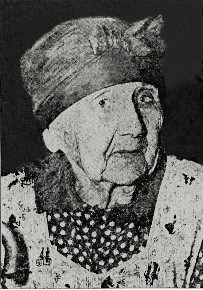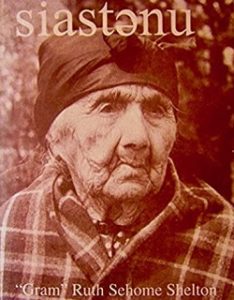
~ Good Will Ambassador for her People
By Betty Gaeng
As a young woman Ruth Shelton was first a wife and a mother. Later with her third and final husband, Tulalip tribal chief and totem carver, William Shelton, she became a good will ambassador for the people of the Puget Sound Indian tribes. Following her husband’s death in 1938, she continued as a well-known and respected spokesperson working for the welfare of her people.
Siastenu Ruth Sehome’s birthplace was Guemes Island, Whatcom County, Washington Territory. The Indian Agency had no records regarding her birth.. The year of her birth was given by Ruth’s elder sister Julia. Julia had been present at the signing of the treaty in 1855 and told Ruth that she was born two years following the signing. Thus, 1857 is the date given as her birth date in all government records and on Ruth’s grave marker.
Ruth’s father was Chief Sehome one of the chiefs of the Clallam Tribe in the Port Angeles area. Her mother Emily Sehome was a member of the Samish tribe, owners of all of Samish, Guemes and Orcas Islands. Both parents were full-blood Indians. In the early days, a portion of what became Bellingham in Whatcom County was named Sehome in honor of Ruth’s father. Ruth Shelton had two sisters Julia (Sehome) Barkhausen, born between 1840-1841; and Sarah (Sehome) Oshan, born 1852.
Ruth and all the tribal members lived in a longhouse about 500 feet long and 70 feet wide. In order to manage this close living life-style, the people were expected to respect each other. Discipline and orderliness were necessary. Children enjoyed fun times, but were taught to obey their elders. During her young years, Ruth Shelton learned all the skills that Indian girls were expected to know before their marriage. She excelled in basket weaving, blanket making and cooking. As a mother she taught these same skills to her daughters.
Ruth married three times—first to a white man in Bellingham and then to William Coy, a full-blood Indian from the Tulalip Indian Reservation. In 1878 Ruth moved to Tulalip with her new husband. This became her home for 80 years. When the 1889 census for the Tulalip Reservation was taken on June 30th, Ruth was listed as a widow. She was left with three young children: Hubert, age 10; Daniel Martin, age 7; and Susan Ann, age 6. Hubert was the only one to survive childhood. He became a leader and successful in business. He built and operated the Mission Beach Resort at the head of Tulalip Bay. Hubert Coy died March 5, 1958 at the age of 79, his mother Ruth Shelton surviving.
Her third husband was William Shelton also a member of the Tulalip Indian Reservation. Together they established not only a stable and good marriage, but also a working relationship promoting interest in the rich history of the native people. Their home on William Shelton’s allotment land was a treasure trove of artifacts of museum quality. Many of the items in the family’s living-room collection were given to *Chief Shelton by admirers from various reservations, and even though the family experienced some tough times, they never sold any part of the collection.
Ruth and her husband William Shelton were a handsome couple and in her youth Ruth Shelton must have been a striking woman. Along with other family members the couple became well known. They appeared at many events in the region, including Seattle, usually dressed in native attire. Ruth and her family created a bridge between the two cultures.
Her daughter Harriet Dover commented that her mother was always patient and understanding with a philosophy that life should be calm and unhurried. She expected her children to live their own lives in this same fashion. She did not believe in moodiness, but rather friendliness toward everyone from the time of arising in the early morning until retiring at night. Ruth taught her children that “Good manners were important.”
Ruth and William Shelton had six children: Robert E., Mary, William Alphonsus, Thelma, Ruth, and Harriet. Harriet (Shelton) Williams Dover was the only child to survive her mother. Harriet was a well-known representative for her people in her own right. A beautiful painting of Harriet hangs in the Tulalip Tribal Council Chambers. She died February. 6, 1991 at the age of 86.
Even though Ruth’s husband William Shelton went back to the ancient Indian religion, Ruth Shelton remained a devout Catholic her entire life. She spoke of the time when as a child living on the Swinomish Reservation at LaConner she took singing lessons from Father Eugene Casimir Chirouse, the renowned early-day Catholic missionary and teacher to the Indians of Puget Sound.
On November 16, 1940, 83 year-old Ruth Shelton made a trip to Seattle to talk to the Ed Dalby, the marine editor for the Seattle Post-Intelligencer. Speaking in the Chinook dialect, she gave a warning that the area would experience a long and hard winter. The following day the paper published an article regarding her visit under the caption “Klonas mika wasa Chinook?” A picture of Ruth Shelton accompanied the article which also stated “chief’s widow knows the answers.”
On Saturday, October. 4, 1958 death came to Siastenu Ruth Sehome Coy Shelton at Providence Hospital in Everett, Washington. She was 101 years old. Ruth Shelton lived to witness the coming of the white settlers throughout the Puget Sound area, skirmishes between the Indians and white settlers, and the ratification of the treaties. She witnessed the evolution of travel from the gliding of canoes on Puget Sound and along the river waterways to the arrival of steamboats, ferries, automobiles, railroads and airplanes (both prop and jet). Satellites circling the earth must have seemed a miracle to Ruth.
Ruth Shelton’s obituary stated that Requiem Mass was held at St. Anne’s Catholic Church on the Tulalip Reservation. A quartet of Indians, Mr. and Mrs. Andrew Joe and Mr. and Mrs. Tommy Bobb of LaConner, sang two hymns in the Indian language which had been translated by Father Chirouse a hundred years before. In keeping with Ruth’s inherited native culture, graveside ancient Indian traditional services were conducted at Mission Beach Cemetery with speeches and the singing of Indian hymns until the casket was lowered to its final resting place next to the grave of her husband William. Indians came from Nooksack, Clallam, Lummi and LaConner reservations to pay their last respects to a long-time beloved friend.
Sources:
 Siastenu “Gram” Ruth Sehome Shelton; The Wisdom of a Tulalip Elder. Transcribed by Vi Hilbert and Jay Miller, recorded by Leon Metcalf. Lushootseed Press (2005).
Siastenu “Gram” Ruth Sehome Shelton; The Wisdom of a Tulalip Elder. Transcribed by Vi Hilbert and Jay Miller, recorded by Leon Metcalf. Lushootseed Press (2005).
Everett Daily Herald—Sept. 1, 1958; Sept. 5, 1958, p. 5; Sept. 14, 1958, pp. 46-47; Aug. 25, 1961, p. B20.
Affidavit by Julia (Sehome) Barkhausen dated April 13, 1918 requesting enrollment into the Clallam Tribe by virtue of her birth (1919 Roblin Rolls). National Archives and Records Administration, Pacific Alaska Region (Seattle).
Census schedule of the Tulalip Reservation of the Tulalip Agency, W.T., taken by W. H. Talbot, United States Indian Agent, June 30, 1889.
Seattle Post-Intelligencer, Nov. 17, 1940, p. 24.
Marysville Globe—Oct. 9, 1958, p. 1.
Washington State Digital Archives.
* Before the Indian Reorganization Act of 1936 there was no official tribal status as a chief. On the other hand, the tribe–and more so the white community–truly called William Sheldon and Chief Sehome that and certainly they deserved the status. In effect William Shelton was a Tulalip cultural leader though the other title is not totally wrong and he was Chief of Police. The Indian Reorganization Act of 1936 allowed the tribes self governence. Shelton died in 1934 so he just missed the chance to actually govern.
© 2009 Betty Lou Gaeng, All Rights Reserved
